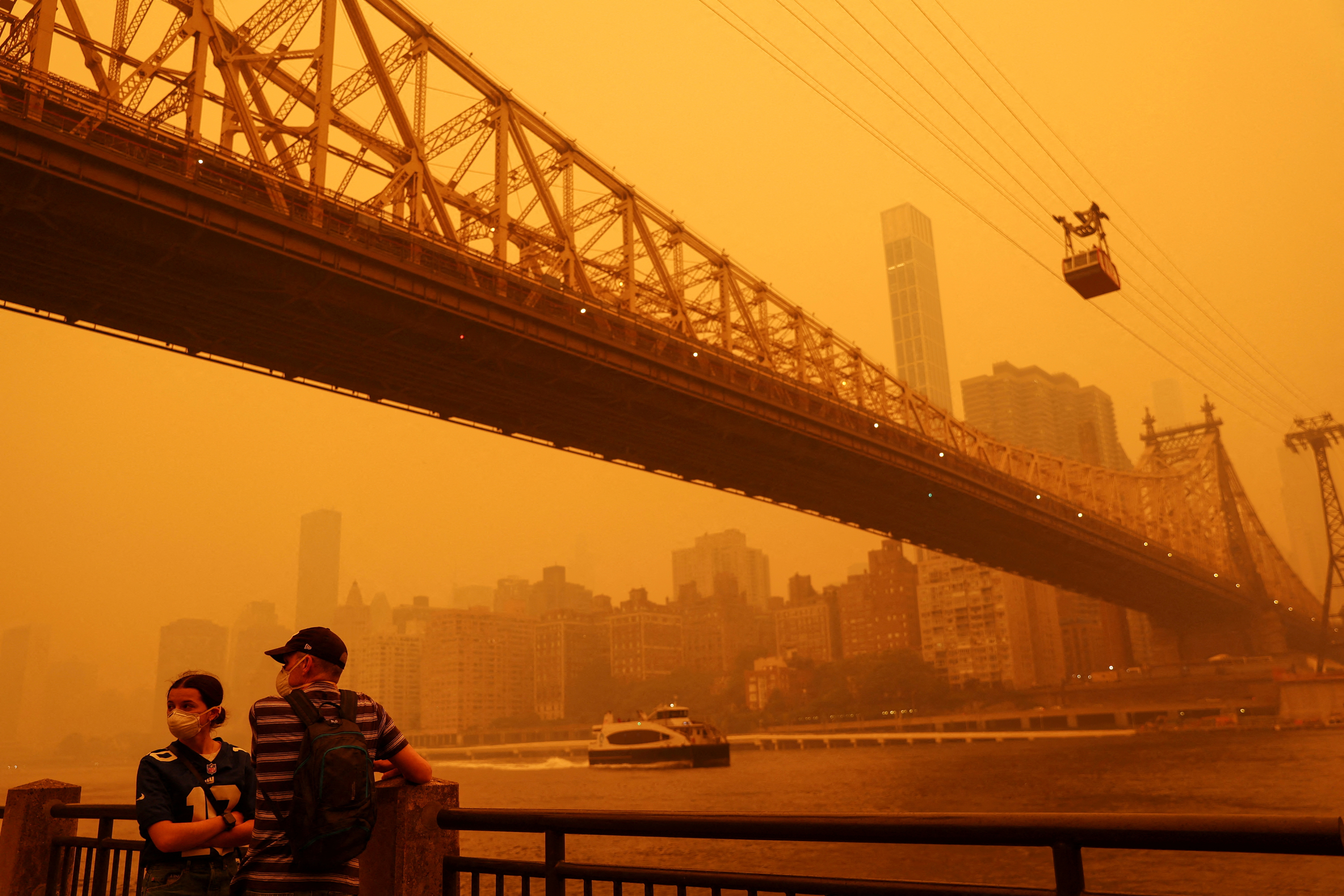
Canada is seeing its worst-ever start to wildfire season, with blazes ravaging much of the country and creating hazardous smoky conditions across the continent and beyond.
After the smoke reached New York earlier this week, on Thursday it blanketed Washington, DC, in an unhealthy haze, prompting many residents to stay indoors.
Here is what we know about the wildfires, their trajectory and climate change.
What started the Canadian wildfires?
Atlantic Canada received low snowfall this winter, followed by an exceptionally dry spring.
Nova Scotia’s capital Halifax received just 120mm of rain between March and May, roughly a third of the average, according to The Weather Network meteorologist Michael Carter.
A scorching late May heatwave pushed temperatures in Halifax to 33C (91.4 F) on Thursday, about 10 degrees Celsius above normal for this time of year.
The wildfires are believed to have been caused either by lightning, as in the case of Quebec, or accidentally by human activity.
Ellen Whitman, a research scientist with the Canadian Forest Service, said there is also speculation that trees felled during Hurricane Fiona, which hit Atlantic Canada in September 2022, or killed by an infestation of forest pests may be providing more fuel than usual for wildfires, but that theory requires further investigation.
While the focus has been on the smoke in eastern North America, fires continue to rage in western Canada.
This view from yesterday in British Columbia. pic.twitter.com/3jUXxYPpwu
— CIRA (@CIRA_CSU) June 8, 2023
Are the wildfires under control?
Not yet.
As of early Friday, there were 427 active wildfires, according to the Canadian Interagency Forest Fire Center; of those, 232 were out of control.
In the West Coast province of British Columbia, authorities reported 81 active wildfires – 28 out of control – while in the province of Alberta, authorities reported 72 active wildfires.
Quebec, on the country’s eastern side, has 128 active fires.
The fires have spread across about 4.3 million hectares (10.6 million acres), roughly 15 times the annual average of the past decade.
Where are the Canadian wildfires?
The forest fires started in late April in British Columbia and Alberta, displacing more than 30,000 people at their peak, and shutting down oil and gas production.
They have now opened new fronts, spreading to the eastern provinces of Nova Scotia, Quebec and Ontario.
Currently, Canada is receiving international help to battle the wildfires. Help has come from the United States, South Africa, Australia and New Zealand. In Europe, France, Portugal and Spain were also sending more than 280 firefighters to Canada.
How are the fires affecting air quality?
On Thursday, authorities in Washington, DC, issued a “Code Purple” air quality alert, warning of “very unhealthy air conditions for the entire public, not just those with respiratory illnesses”.
New York again had the worst air quality on Thursday morning, with an unhealthy Air Quality Index reading of 185, according to a website operated by IQAir.
Readings over 100 are classified as “unhealthy”, and those exceeding 300 are “hazardous”.
On Wednesday, authorities in Canada said Ottawa’s air quality was among the worst.
Experts have noted that acrid clouds of smoke and ash could continue to affect daily life for people in the US and Canada for the next several days.
Why is the smoke reaching so far away?
Strong winds high in the atmosphere can transport smoke long distances, and it is common for large, violent fires to create unhealthy conditions hundreds of kilometres away from where forests are burning.
In Canada, air is circulating counterclockwise around a low-pressure system near Nova Scotia. That sends air south over the fires in Quebec. There the air picks up smoke, and then turns east over New York state, carrying smoke to the eastern seaboard.
The smoke has now also been detected thousands of kilometres away in Norway, the Scandinavian country’s Climate and Environmental Research Institute NILU said on Friday.
“Very weak” concentrations of smoke particles have been detected since Monday, in particular at the Birkenes Observatory in southern Norway, researcher Nikolaos Evangeliou told AFP news agency.

What is the outlook?
Warm, dry conditions are forecast to persist for months across Canada though occasional rains and cooler temperatures are expected to bring short-term relief.
The Weather Network’s longer-term forecast expects Nova Scotia temperatures to be slightly warmer than normal for the rest of the summer.
What role is climate change playing?
Whitman of the Canadian Forest Service, said it is difficult to determine the effect of climate change on a single fire season. Atlantic Canada has been much hotter than usual and scientists expect temperatures in the region to continue to rise in the coming years.
For coastal regions, climate change is expected to bring more rain, which should reduce the risk of wildfires, but a warmer atmosphere is more efficient at pulling moisture out of soils, a factor that increases fire risk.
Widespread spring fires across the whole of Canada are also unusual, and research shows fire seasons across North America are getting longer.
A warming planet will produce hotter and longer heatwaves, making for bigger, smokier fires, according to Joel Thornton, professor and chair of the Department of Atmospheric Sciences at the University of Washington.
I have never seen a vertical wall of smoke like this one near Fox Creek, Alberta on Sunday.
And the strangest thing about this moment was I couldn't smell any smoke. #ABfire #ABfires pic.twitter.com/I6vmJvUay4
— Kyle Brittain (@KyleBrittainWX) May 17, 2023







